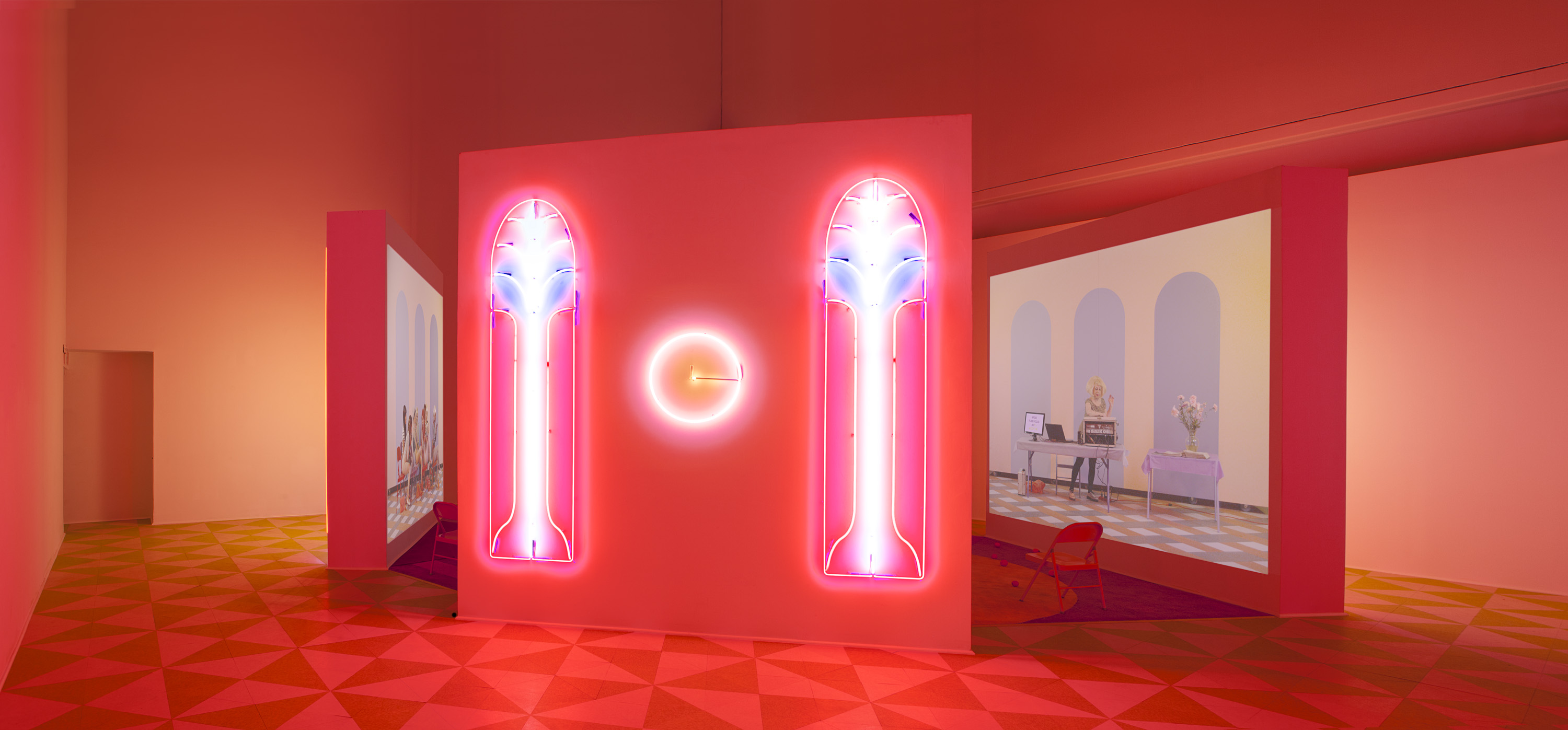
Alex Da Corte (b. 1980) with Jayson Musson (b. 1977), Easternsports, 2014. Four-channel video, color, sound; 152 min., with four screens, neon, carpet, vinyl composition tile, metal folding chairs, artificial oranges, orange scent, and diffusers. Score by Devonté Hynes. Collection of the artists; courtesy David Risley Gallery, Copenhagen, and Salon 94, New York. Installation view, Institute of Contemporary Art, University of Pennsylvania, 2014 © Alex Da Corte; image courtesy the artist and Institute of Contemporary Art, University of Pennsylvania
During his opening remarks for Dreamlands: Immersive Cinema and Art, 1905-2016, at the Whitney Museum of American Art, Adam D. Weinberg, the Alice Pratt Brown Director at the museum quoted Tom Gunning, “The danger lies in the fact anything may become habitual, and thereby fade from our consciousness. Art exists to make us discover the sensation of things. But sometimes, an art form itself gets taken for granted. Then it is up to us to rediscover what has been neglected, and forgotten and that is the task of art history and criticism.” He goes on to say, “This exhibition invites us to regain our wonder at visual movement, and therefore, the wonder of cinema itself.”

Stan VanDerBeek, Installation View, “Movie Mural,” (1967) at “Dreamlands: Immersive Cinema and Film, 1905-2016” Whitney Museum of American Art, NY. Photo by Jongho Lee. 2016
The exhibit aims to track not only moving image and technology, but how artists have manipulated and transformed said technology. This is utilized in order to manipulate space, form and time, further exploring themes of identity and narrative, and blurring the line between reality and illusion. Before examining the specifics of the exhibition, it should be noted that this exhibit is a huge undertaking. Strictly from a technical point of view alone, each artwork requires a specific amount of expansive space (Stan VanderBeek’s Movie Mural uses eight different projectors and seven different projection screens), and the consideration of audio, light, sometimes even smells and tactile elements required to fully immerse oneself in such environments. There is a clear chronology to the exhibit where the viewers can focus on the three moments of technological evolution ranging from the 20’s to the late 60’s to early 70’s and finally the present according to Chrissy Iles, who seamlessly curated Dreamlands: Immersive Cinema and Art, 1905-2016. Iles also curated Into the Light: The Projected Image in American Art 1964-1977, an exhibition addressing the incorporation of moving image into large art installations, at the Whitney a little more than a decade ago.
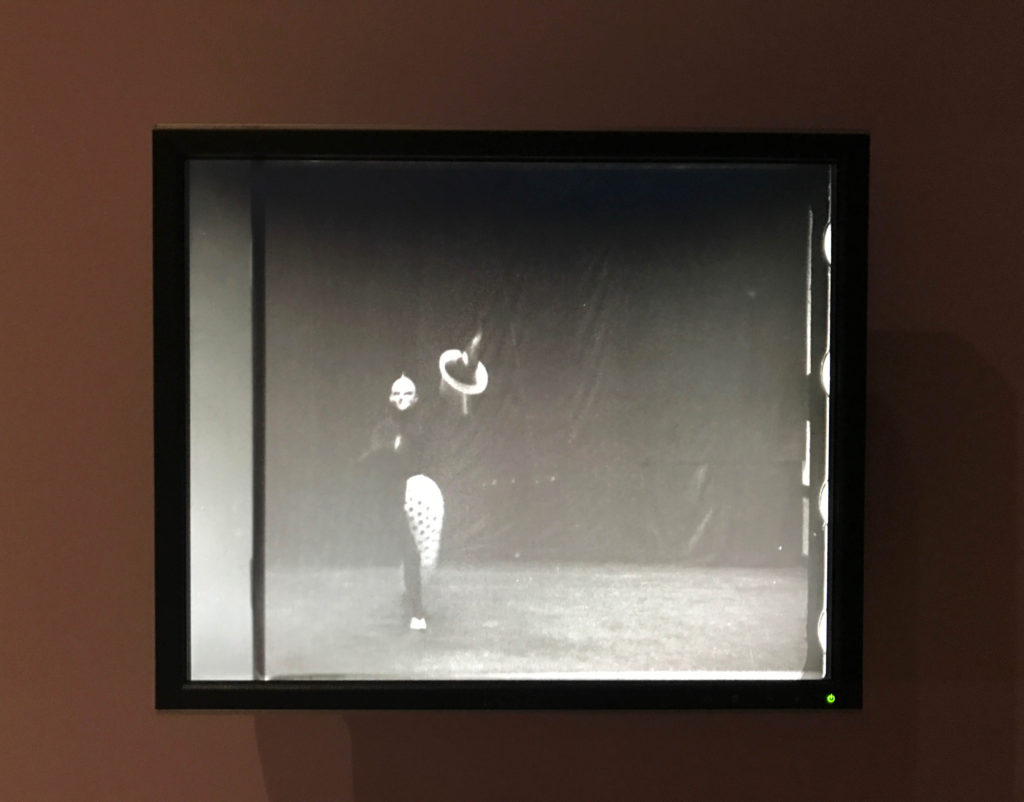
Oskar Schlemmer, Film Still from Archival footage of Oskar Schlemmer, Lis Beyler, and Joost Schmidt dancing in costumes from “Das Triadische Ballett,” (1926) “Dreamlands: Immersive Cinema and Film, 1905-2016” Whitney Museum of American Art, NY. Photo by Jongho Lee. 2016
Oskar Schlemmer sets the stage for a lot of the cinematic and performative themes explored by the following artist in the exhibition with Das Triadische Ballett [Triadic Ballet] (1922/1970), which he directed, as well the archival footage adjacent to the the Ballet, of himself, Lis Beyler, and Joost Schmidt dancing while wearing a variation of the costume in the third section of the ballet. This dance aimed to transform space through dematerializing the human body by using restrictive costumes, reducing the human form and abstracting the space. Adjacent to these two films is Edwin S. Porter’s Coney Island at Night, which was a commissioned piece to demonstrate both the incandescent light bulb and the motion-picture camera invented by Thomas Edison. Even though the panning shots are simple in cinematography, the footage of Dreamlands and Luna Park serves as a study of the abstraction of light and form through means of recording, rather than a mere documentation of the parks. The idea of dismantling conventional qualities of film seen in these earlier works is the foundation for vocabulary in what one would consider “immersive cinema.” One of the conventions that Joseph Cornell abandons in Rose Hobart (1936) is the idea of the narrative, thereby emphasizing the atmosphere created by his slowed down, heavily blue-tinted, chopped up version of the black and white Hollywood film, East of Borneo (1931).
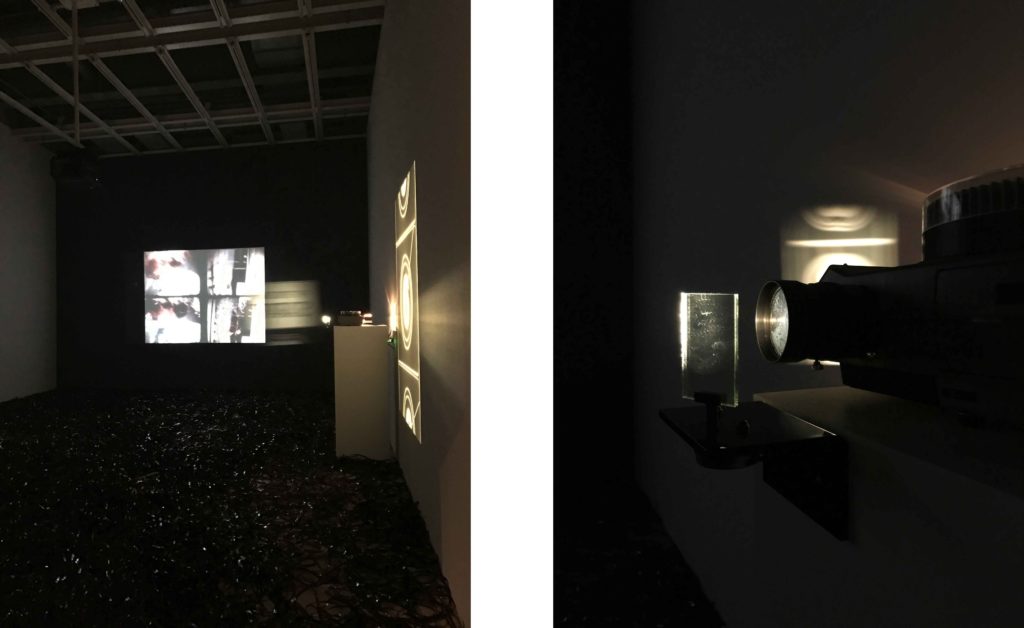
Jud Yakult, “Destruct Film,” (1967) Left: Installation View Right: Closeup of rotating film slide and projector, “Destruct Film,” (1967) at “Dreamlands: Immersive Cinema and Film, 1905-2016” Whitney Museum of American Art, NY. Photo by Jongho Lee. 2016
The redefined vocabulary of cinema crosses paths with more traditional art forms of painting, photography and sculpture with works like Stan VanDerBeek’s Movie Mural (1968) and Jud Yalkut’s Destruct Film (1967). By projecting various moving and still images on multiple screens that don’t align with the projection, VanDerBeek deals with notions of the picture plane and framing in a very painterly manner, all while taking another step towards creating an immersive experience, anticipating the overwhelming role that digital imagery has grown to have. In Yalkut’s Destruct Film (1967), viewers have a physical experience as they wade through reels of unspooled film, and once inside, are immersed in a mystifying set of kaleidoscope images projected on the wall, as well as the ones that are constantly spinning around the walls of the room. In Anthony McCall’s Line Describing a Cone (1973), the light emitted from the projection, a circle slowly on the wall, becomes the subject of a sculpture. Only seen faintly through the mist in the room the beam of light, originally a line, gradually becomes a cone as the circle is projected the wall. This gradual appearance of the light allows viewers to actively engage with the work, rather than being a passive observers.
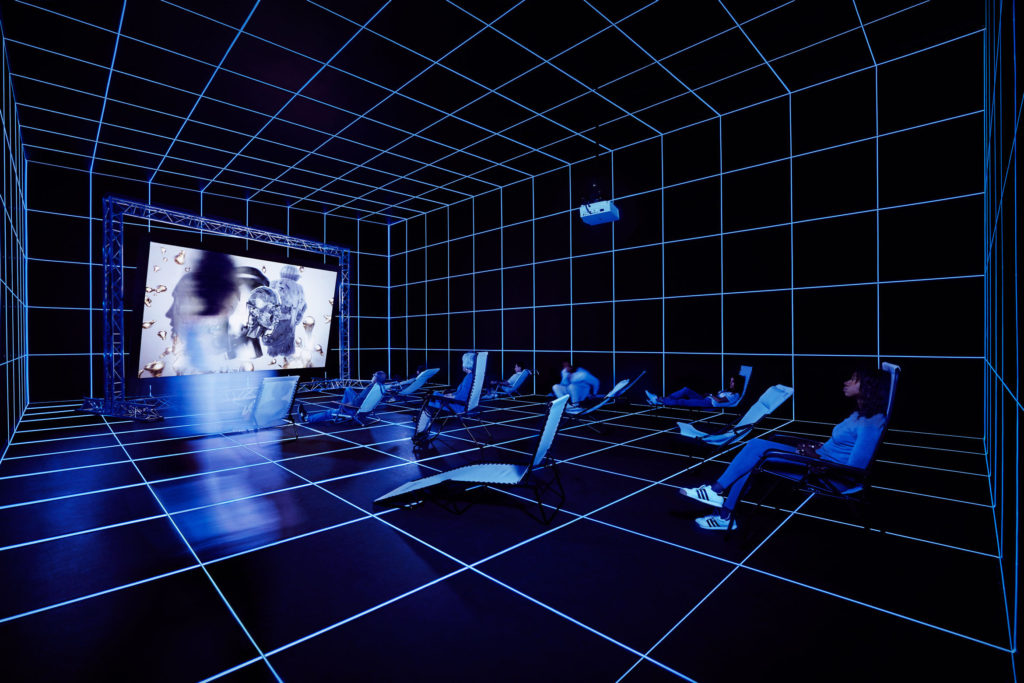
Hito Steyerl, Factory of the Sun, (2015) Installation view: Invisible Adversaries, Hessel Museum of Art, Bard College, Annandale-on-Hudson, New York, 2016. Bard College, Annandale-on-Hudson, New York; Marieluise Hessel Collection. Image courtesy of the artist and Andrew Kreps Gallery, New York. Photograph by Sarah Wilmer
More recent advancements in technology include rendering virtual realities, as well as environmental cinema. Works by Dora Budor, Hito Steyerl, and a collaboration between Alex Da Corte and Jayson Musson display perhaps some of the most technologically ambitious works in Dreamlands. In Budor’s Adaptation of an Instrument, (2016) built specifically for this exhibition, the environment constantly responds to the viewers inside, emulating the neurological pathways that run through a human body. The instrument, as impressive as it is, can only come alive through a human interaction. Similarly, Steyerl’s environment in Factory of the Sun (2015), commissioned for the German Pavillion at the 2015 Venice Biennale, grids the dark room with blue lines, using motion sensor studios as a model. In the room, is a screen where different videos with different levels of reality are flipped through like channels or video games, playfully commenting on the omnipresence of the digital and the line between reality and fiction. In what is perhaps the most visually striking work of the exhibition, Alex Da Corte and Jayson Musson collaborate in producing Easternsports, (2014) described as “an immersive environment of color, light, scent, music, spoken words, and videos.” Easternsports exhibits all the elements of immersion, incorporating all the senses to create an experience. The sets and choreography in the video created by Da Corte bring to mind the movements and costumes of aforementioned Oskar Schlemmer’s Triadic Ballet.

Ivana Basic, Installation View, SOMA (2013-2016) at “Dreamlands: Immersive Cinema and Film, 1905-2016” Whitney Museum of American Art, NY. Photo by Jongho Lee. 2016
Throughout the timeline of this exhibit, there are artists who have used ideas and technological concerns around cinema and moving image, to address political and identity-based themes that question the exact technology involved in their creative process. The project No Ghost Just a Shell is a crucial example. Artists Pierre Huyghe and Philippe Parreno purchased the executive rights to Annlee an 11-year-old animated character from a Japanese agency and offered her to a group of artists. All eight films incorporating Annlee have been brought together for this exhibition. This project arouses inquiry of creative authority and legal rights, while exploring the boundaries of how an artwork exists and the constant shift of interpretation of Annlee caused by different renderings of the same entity by different artists. Ivana Basic’s SOMA (2013- ) is another piece that can appear in various manifestations. Basic deals with a more personal identity than that of Annlee, as she 3-D scans her body and makes it available to anyone that wants to render it. By doing so, her body exists in countless ways, including in the future through means of production that have not even been realized yet. In the existing rendering at the exhibit, her body appears both as a sculpture and an animation, both versions of her body that cannot exist in real life. In a Room of One’s Own (1990-93) by Lynn Hershman Leeson, the viewer peers into an interactive sculpture based on Thomas Edison’s kinetograph. Only when the viewer peers inside, a television in the little room triggered, along with a female voice that confronts the voyeurism involved. The work, using Edison’s invention at it’s core, functions as not only a commentary on voyeurism, but an indirect criticism of the omnipotence of technology and the objectification of women through the male gaze.
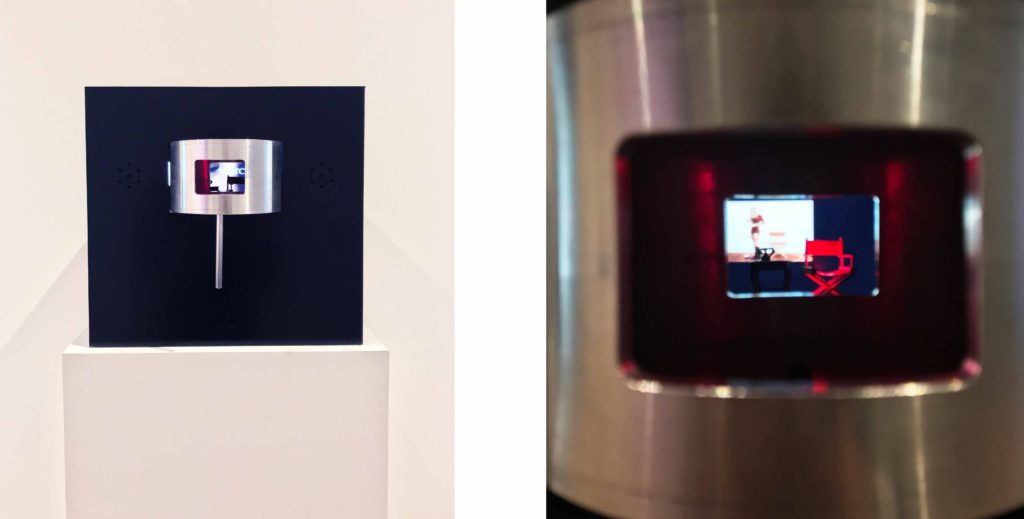
Lynn Hershman Leeson, “Room of One’s Own,” (1990-93) Left: Installation View, Right: Close-up view of interior, at “Dreamlands: Immersive Cinema and Film, 1905-2016” Whitney Museum of American Art, NY. Photo by Jongho Lee. 2016
All in all, the exhibition is a spectacular survey of different ways artists have used cinematic technology to constantly create new physical and virtual grounds to explore. Furthermore, it emphasizes the technology that one takes for granted today and reminds us of the critical eye artists carry while exploring uncharted grounds. We are made acutely aware of anything that “may be habitual,” as Tom Gunning states through artists’ devotion to examine and question in this exhibition.
The Whitney Museum of American Art will also present a film program along with the landmark exhibition. Dreamlands: Expanded is a series of film screenings and expanded cinema event that will take place at various venues including; Microscope Gallery in Bushwick, Brooklyn, as well as the Knockdown Center in Maspeth, Queens.
___________________________________
